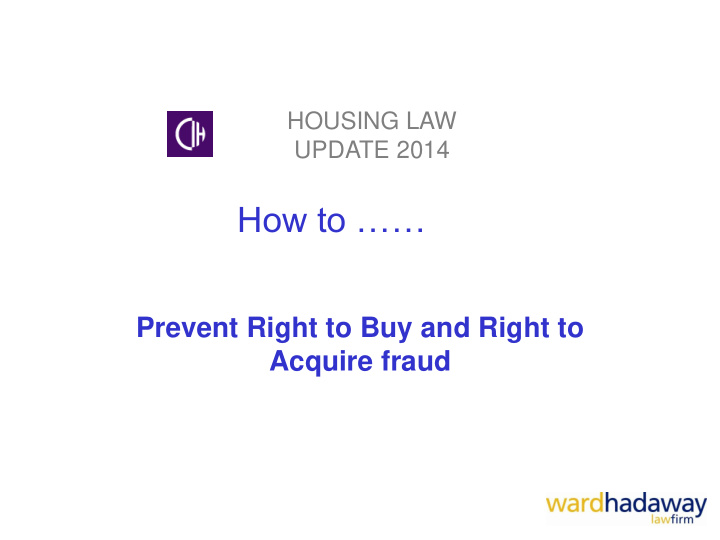



HOUSING LAW UPDATE 2014 How to …… Prevent Right to Buy and Right to Acquire fraud
1. Right to buy/Right to Acquire: In context • Since the Housing Act 1980, 2 million households have purchased their council home. • 160,000 sales a year in early 1980s; • > 4,000 in 2011. • 620,000 Housing Association tenants have preserved Right to Buy. • HA tenants may have Right to Acquire for properties built/transferred by Local Authority to HA post 1.4.97.
2. The Discount/Incentive • Discount after 5 years occupation • Houses: 35% of value + 1%/per additional year to maximum 60% • Flats: 50% + 2%/year per additional year to maximum 60%
2. The Discount/Incentive (Continued) • Recent substantial increases in levels of discount • 1 April 2012: £75,000 • 25 March 2013 £100,000 in London • Proposals to • Increase discount to 70% • Possibly reduce qualifying period to 3 years
3. The Problem People without the RTB, exercising the RTB. • Not in occupation; or not in lawful occupation. • False information in support of application. • 2011/12 » 38 cases » Value £1.2m » 52% increase since 2008 • Protecting the Public Purse 2012 (Audit Commission)
4. Prevention • Understand the Fraud • Misrepresenting tenancy length/history • Not using as principal home • Misrepresenting household composition: adding non entitled joint tenant • Tenancy Fraud Policy: include RTB risk • Dedicated team » 85% of organisations with a team could detect/act on fraud; cf » 19% of those without
4. Prevention (Continued) • Awareness • Briefings to relevant groups » Housing Officers » Janitors, Caretakers, Cleaners » Repair managers » Tenants • Education • Signs of fraud • Tenancy/application fraud training • Id verification – signs of forgery, how to identify false documents
4. Prevention (Continued) • Publicise • Policy on Tenancy/Right to buy or acquire fraud • Potential penalties • Enforcement Action taken
5. ID Verification Know your tenant at every stage: • Application for social housing • Sign-up to a new tenancy • Tenancy audits • Application for assignment or mutual exchange • Application for succession • Changes to the tenancy, including adding another tenant or change of household composition/circumstances
5. ID Verification (Continued) Carry out enhanced checks of: • ID documents • Proof of residency • Proof of tenancy history Use credit reference agency or other sources to verify application information
6. ID Checks: Photos • Full UK or EU driving licence with photo • 10 year UK or EU passport • EU identity cards • Biometric residence permits – (non EEA foreign nationals)
6. ID Checks: documents • UK certificate of naturalisation • BR2102, BR2103 or BR5899 letter confirming eligibility for state pension • Current child benefit/job seeker’s allowance book or card • Birth/marriage/adoption certificate • Medical card with National Insurance number • Certificate of HM Forces employment • P45, P60 or payslip
7. Residency Checks: • Copies of current • P45, P60, payslip • Benefit/Pension correspondence • Utility/Council Tax/Mobile phone bill • Bank/Credit Card statements
8. Verifying claims Developing anti-fraud culture – verify information and evidence • Check • Photographs match • Date of birth matches records and is appropriate • Signatures match • Documents are genuine with no signs of tampering
8. Verifying Claims (Continued) Check ID provided against: • Internal data (rents/housing management/repairs database) • Housing Benefit data • Electoral Roll • Social media (Facebook etc) • Internet searches • Land Registry • Address services 192.com • Data sharing organisations eg. Callcredit
8. Verifying Claims (Continued) Check eligibility • Tenant resident for qualifying period • Additional applicants resident for 12 months • Historical details: any transfers during tenancy? Preserved RTB from previous LL? • Notice to Quit served by tenant/joint tenant? • Possession order, suspended possession order?
9. Suspicious Circumstances Interview: • Applicants whose circumstances require verification/clarification • Invite them to sign statement about circumstances • Warn them about fraud procedures and related offences • Offer opportunity to amend their statement before signing it
10. Vulnerable Tenants • Be aware of pressure on vulnerable/older tenants by unscrupulous finance companies/family members • Ensure they are aware of responsibilities • Payment of any loan • Long term security: shorthold tenancy may render them homeless • Repairing obligations • Government has updated guidance leaflets
11. Enforcement • Misrepresentation Act 1967 • Fraud Act 2006 • Proceeds of Crime Act 2002
12. Case Report • Haringey LBC – v- Hines (2011) • Dec 2001: H applied for RTB from LB Haringey • Oct 2002: lease granted • Haringey discovered following HB conviction in 2008 that H had moved out of property early in 2002; so had not been a secure tenant
12. Case Report (Continued) • Fraudulent misrepresentation but no “rescission” of contract due to earlier case law; damages awarded for misrepresentation • Court of Appeal dismissed claim, and overturned damages award because the serious allegations had not ben put to T in cross examination • Had this case been conducted in a different way, Haringey may have been able to set aside contract, and claim damages
13. Case Studies: • CIH Briefing Note: Prevent RTB Fraud • Bristol CC • Bolton at home • Barking and Dagenham
13. Case Studies (Continued) • Sandwell MBC: • Specialist Investigation Team : HB staff and co- opted housing manager. • Reviewed Documentation so fit for purpose • Improved Key Fob security systems • Arranged local press coverage • Results: • Prevented 3 fraudulent RTB applications. • Recovered: » 5 properties obtained by false declaration » 36 abandoned properties
13. Case Studies (Continued) • Top tips • Ensure investigators are focused on fraud, not ASB etc. • Support from Cabinet Members/Senior management • Data matching/National Fraud initiative • Keep abreast of news: RTB incentives = increase in applications and fraudulent ones • Pursue offenders through courts where possible
Recommend
More recommend